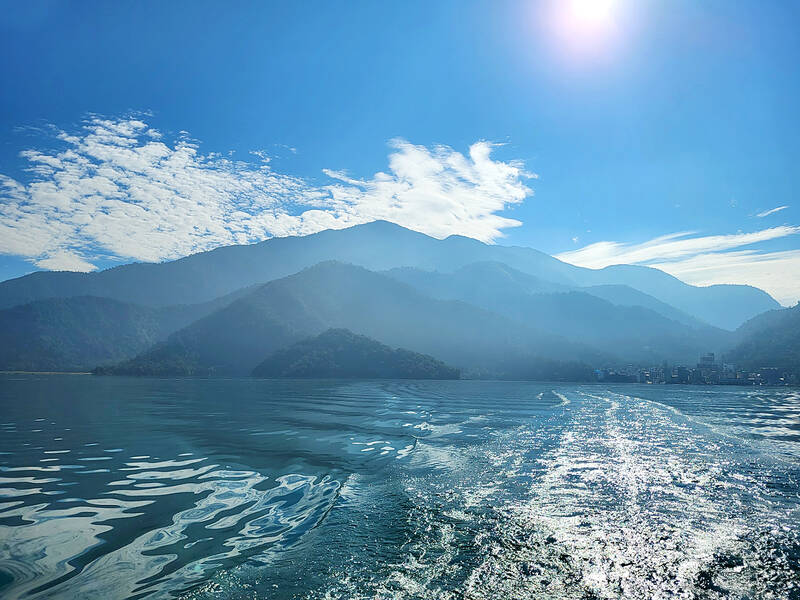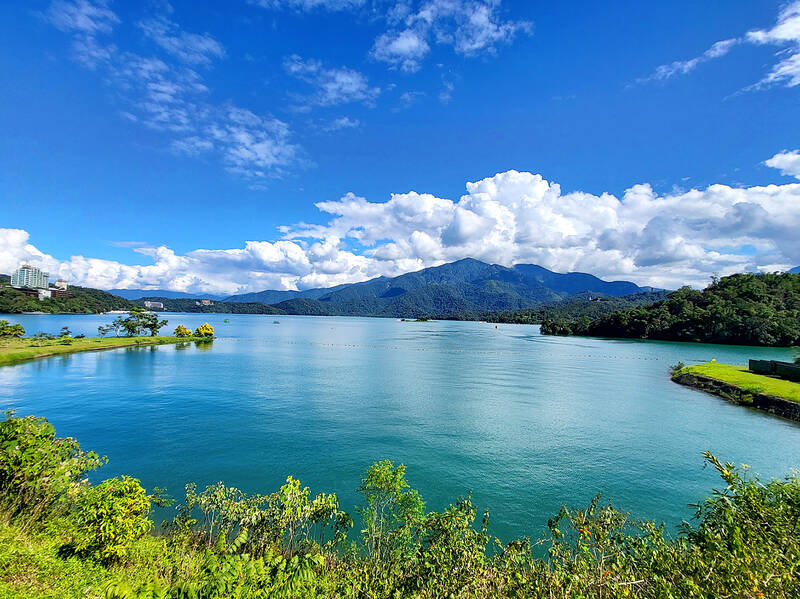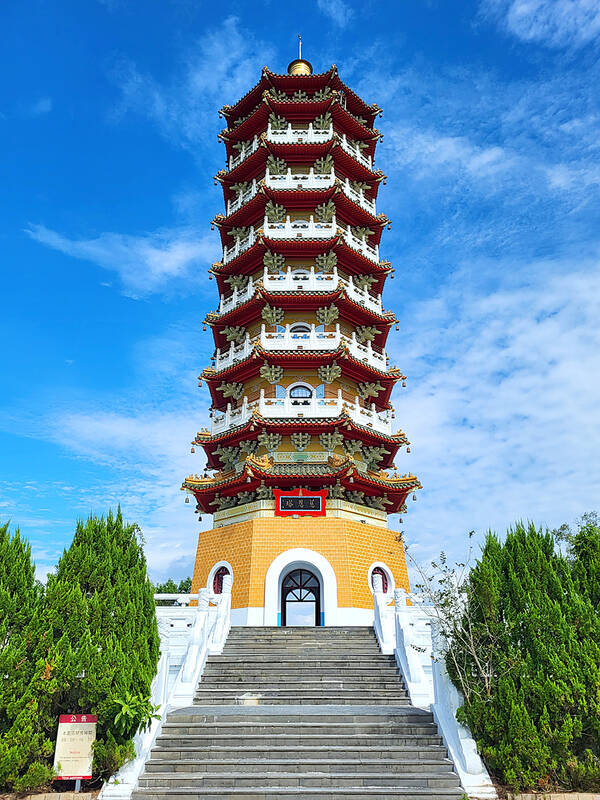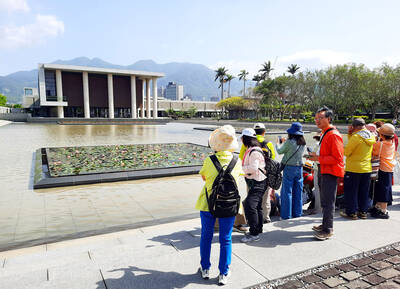Surrounding Sun Moon Lake (日月潭) there are a multitude of activities suitable for all the family that can be enjoyed on a day or weekend trip. On a recent visit, I hiked to a peak, rode a ferry across its emerald waters and a visited a pagoda with outstanding views.
Located in Nantou County’s Yuchi Township (魚池) at 748m above sea level, Sun Moon Lake it is an excellent destination in summer or winter with a year-round moderate temperature.
The lake is the largest body of water in Taiwan with a circumference of 27 kilometers. The east side of the lake resembles a sun while the west side resembles a moon — hence the name.

Photo courtesy of Mark Roche
MOUNTAIN HIGH
The lake and its surrounding countryside have been designated one of the thirteen national scenic areas in Taiwan. On a recent trip I enjoyed a walk along the Maolan Mountain Hiking Trail (貓囒山步道), which is located at the northern edge of the lake and rises to an elevation of 1,020 meters.
The Japanese colonial government established the Maolan Mountain Tea Research and Extension Station here in 1936, mainly to carry out the improvement of growing leaves for black tea.

Photo courtesy of Mark Roche
On the right side of the entrance to the trail there are several old Japanese-style buildings that houses employees for the tea research station that are made with cypress with the inside walls being of bamboo. They have been designated by the county government as an historic site.
The trees alongside the trail are Ceylon olive elaeocatpus, so-named because they are native to Sri Lanka (formerly Ceylon) and India and have fruit that resembles the olive. They are evergreen trees and the red leaves turn fiery red in the fall and winter and, when they fall, pave the ground with a red carpet that makes this a favorite place for taking wedding pictures.
The hike to the peak of the mountain, all on paved road, only takes an hour and is well worth the effort for the spectacular views of the whole area. The warm sunrise illuminates the tranquil lake water and the tea plantation that covers the mountainside, showing another side of the lake’s beauty. There is a weather station on top, which is one of the four highest in Taiwan.

Photo courtesy of Mark Roche
Maolan Mountain is also No. 49 of the Xiaobaiyue (小百岳) or “Small 100 Peaks” — specially selected “suburban mountains” that are more accessible in Taiwan’s cities and counties.
CRUISING THE LAKE
A visit to the lake wouldn’t be complete without enjoying the ferry service across it that connects the main tourist area piers of Shueishe (水社碼頭), Itathao (伊達邵碼頭) and Hsuanguang (玄光碼頭). This service, which triangulates between the three piers runs from 9am to 5pm daily and costs NT$30. Both Shueishe and Itathao have an abundance of guest houses and restaurants and either of these locations is ideal for an overnight stay.

Photo courtesy of Mark Roche
Taking the ferry across allows visitors to fully appreciate what a substantial body of water the lake is — the furthest points between the two main piers is nearly 3 kilometers in distance.
Although I didn’t do so on this occasion I would highly recommend renting a bike to enjoy the bike path that circles the lake. There is a Giant bicycle service station located at the Shueishe Pier. Rentals are reasonable and start at NT$200 per hour (e-bikes are also available).
PAGODA IN THE CLOUDS
One final place to visit is the Cien Pagoda, (慈恩塔), located just a few kilometers from either Itathao or Hsuanguang. Former president Chiang Kai-Shek (蔣介石) had it built in 1971 in an imposing traditional Chinese style in memory of his mother. The bamboo forest lining the route to the gardens at the top is the picture of tranquility.
The building in front of the pagoda was used as a rest house by Chiang and became one of his favorite places to visit.
The pagoda is 46 meters in height and sits on the 954 meter-high Shabalan Mountain (沙巴蘭山) bringing its top to an even 1,000 meters above sea level. The pagoda is an octagonal building; the three floors at the base are painted in white, while the nine floors of the main body are painted in golden red.
The view from the top offers spectacular views of Sun Moon Lake and the surrounding mountains.
Regardless of age, fitness or interests there is something for all the family to enjoy at the lake for a night or two and be sure of finish off your day at one of the many coffee shops or sipping a beer with a lake-side view.

When the South Vietnamese capital of Saigon fell to the North Vietnamese forces 50 years ago this week, it prompted a mass exodus of some 2 million people — hundreds of thousands fleeing perilously on small boats across open water to escape the communist regime. Many ultimately settled in Southern California’s Orange County in an area now known as “Little Saigon,” not far from Marine Corps Base Camp Pendleton, where the first refugees were airlifted upon reaching the US. The diaspora now also has significant populations in Virginia, Texas and Washington state, as well as in countries including France and Australia.

On April 17, Chinese Nationalist Party (KMT) Chairman Eric Chu (朱立倫) launched a bold campaign to revive and revitalize the KMT base by calling for an impromptu rally at the Taipei prosecutor’s offices to protest recent arrests of KMT recall campaigners over allegations of forgery and fraud involving signatures of dead voters. The protest had no time to apply for permits and was illegal, but that played into the sense of opposition grievance at alleged weaponization of the judiciary by the Democratic Progressive Party (DPP) to “annihilate” the opposition parties. Blamed for faltering recall campaigns and faced with a KMT chair

Article 2 of the Additional Articles of the Constitution of the Republic of China (中華民國憲法增修條文) stipulates that upon a vote of no confidence in the premier, the president can dissolve the legislature within 10 days. If the legislature is dissolved, a new legislative election must be held within 60 days, and the legislators’ terms will then be reckoned from that election. Two weeks ago Taipei Mayor Chiang Wan-an (蔣萬安) of the Chinese Nationalist Party (KMT) proposed that the legislature hold a vote of no confidence in the premier and dare the president to dissolve the legislature. The legislature is currently controlled

Dull functional structures dominate Taiwan’s cityscapes. But that’s slowly changing, thanks to talented architects and patrons with deep pockets. Since the start of the 21st century, the country has gained several alluring landmark buildings, including the two described below. NUNG CHAN MONASTERY Dharma Drum Mountain (法鼓山, DDM) is one of Taiwan’s most prominent religious organizations. Under the leadership of Buddhist Master Sheng Yen (聖嚴), who died in 2009, it developed into an international Buddhist foundation active in the spiritual, cultural and educational spheres. Since 2005, DDM’s principal base has been its sprawling hillside complex in New Taipei City’s Jinshan District (金山). But